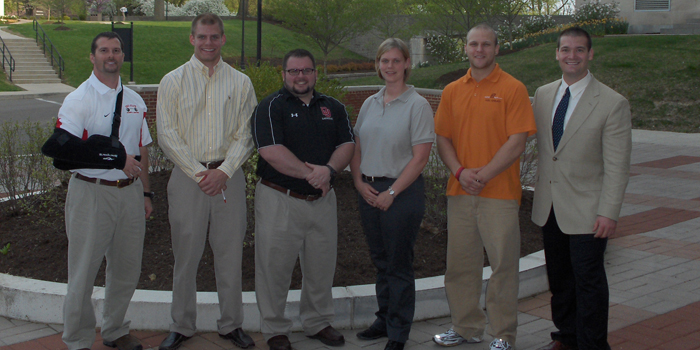
ATCs and S&Cs
After listening to interviews from Charlie Weingroff and David Joyce, two very distinct ideas on the culture of athletic training made me realize that a much needed paradigm shift is happening with Certified Athletic Trainers (ATCs).
Strength Coaches and ATCs have been able to draw a lot of parallels with their support type positions. Assistants for both are often underpaid and under appreciated. But this bond doesn't help much sometimes in developing solid working relationships. As much as coaches and trainers can relate and see similarities in their situations, there has been a gap in the communication. Specifically, there may be different ideas in what is actually best for the student athletes.
Anytime you determine what is best for your athletes based on what fits in only your scope of practice; you have limited your entire program.
I have a lot of good friends who are athletic trainers it may be more than a coincidence that I have stayed friends with the trainers who I felt cared the most for their athletes. I guess I make the mistake of judging people by how they treat others.
But as the gap between training and rehab closes, integration is much more needed than ever. There is a difference between collaboration and cooperation. The biggest challenge between coaches and trainers is integrating a training protocol but staying within the scope of practice. This reminds me of a saying about athletics.
Fans go to the games to be coaches
Coaches go to the games to be refs
Refs go to the games to be fans
Pretty stupid, I know but you can relate it to this.
Strength Coaches sometimes want to act like Athletic Trainers
Athletic Trainers sometimes want to act like Physical Therapists
Physical Therapists sometimes want to act like Strength Coaches
Again, not necessarily true but there are instances that make a lot of us think this. So how do we coordinate our efforts? This is so dependent on the work environment and setting that I doubt I could articulate ideas without sounding too vague.
So, ATCs do not need advice from a former strength coach, I know. But, most of the ATCs I know care about their athletes and have always had the athletes' interest at heart. So here are two points.
Athletic Trainers need to think of rehab from the performance side, not the medical side
The athletic trainer in a University setting should evaluate how they evaluate the return to play status of athletes. David Joyce has talked specifically about the time-frame allotted for rehab.
Think about it. Anytime you hear an injury there is always a recovery and rehab duration associated with it. This really is a medical diagnoses and an over-generalization. Yes, a broken bone wil take 6 weeks, so that will be pretty standard. But, an ankle sprain, hamstring strain, or contusion that is not evaluated day-by-day is foolish. This is another reason why daily re-evaluation needs to happen with standardized return-to-play protocols.
I am aware that a lot of Sports medicine departments are operating this way. The more staffs that are proactive, the more buy-in the athletes will have. Athletes often have trust issues with trainers. By communicating more effectively with injuries, the athletes start to understand not only when and how they will get back on the field but that they are working together with the ATC.
One huge area of contention is the return-to-play protocols for concussions. The order of activity is extremely skewed for athletes. Wherein neck strength is key preventive measure, strength training is the second to last activity allowed right before full-contact. Having a set assessment protocol for muscular strength which includes a baseline can be a logistical nightmare, but what is probably best for the athlete.
For a detailed look at training training protocols for athletes to prevent concussions, check out this article.
Head Games: Training the Neck to Reduce Concussions
Athletic Trainers need to think CAN and not CANT
This is as much of a mentality thing, but deleting exercises without appropriate regressions is not only lazy, but irresponsible. This lets the athletes off the hook just so the ATC can cover their ass. Good trainers understand how, when, and why to push athletes to the point of progress. Again, overall I would say this is changing.
The biggest gap in athletic performance training is always after the athlete is "cleared" and done with rehab, but they are not "Full go" yet. So when these athletes have limitations, it's time to get proactive, positive, and creative.
The Examples from the DUSB team:
Sam Rumschlag: Became NCAC MVP as a pitcher with a broken foot. She could not do anything standing whatsoever in training.
Jess Robertson: Had a broken bone in her elbow and she couldn't straighten her arm.
Heather Larsen: Torn ACL and I literally could not find a SL exercise this girl couldn't master.
The common denominator was they were all very tough, dedicated, and bought in to what ever we had in store. We gave them exercises that were more difficult, took more focus, can addressed their weak points. They can back healthier, better, and more jacked.
For a more detailed look at one of the best team's I've ever trained, check out this article.
Why Softball Players are Tougher than Baseball Players
Limiting an athletes training protocols is almost as bad as prolonging their return status. Just make sure you have a reason for everything. If the athlete's safety is not jeopardized then have the best reason possible for why you have established limitations.
Assumptions for the Strength Coach
DON'T assume the ATC has a basic knowledge of strength & conditioning.
Yes, they will have a good base for anatomy and physiology, but the gap comes when practical application comes into play. For example, an ATC will know exactly what muscle groups need to get stronger and what movement will address that strength to rehab an injury. Where they may be limited is knowing what specific exercises, progressions, and regressions are available based on facilities. Some of the advanced methods or variations may be unfamiliar to them.
DON'T assume the ATC knows anything about the strength & conditioning program.
There are a few ATCs that are actively involved with understanding the physical training methodology used for their teams. But, those are not the norms by far. I would love when the trainers (who are often in the "CANT" mentality would tell me that didn't want the athlete doing this or that. It was usually something that we didn't even do. Or is was in a parameter we wouldn't use. Something like, "Hey, I don't want so-and-so doing any conventional deadlifts, mmm-kay?"
"Sure. no problem. Haven't done those with athletes in 12 years but ok, I wont add them this week." Or, they would tell me know to do any long distance or high-rep activities when we just don't do it. Nothing against deadlifts or high reps, but this lack of knowledge shows lack of professionalism.
DON'T assume the ATC has ever set foot in a weightroom let alone your weightroom.
Yes there are a large number of ATCs that train. My boy, Derek Fry was played college football, qualified for the JR session of the Olympics in weightlifting, and made it as a funded athlete for US BobSled. The dude knows his way around a weight room that is an anomaly. There are often times when a trainer would tell me that so-and-so will need to "leg press" instead of squat. Not sure what was worse, the fact that he/she though the leg press was safer or the fact that they didn't know we didn't have a leg press machine. Shit like that happens all the time. "Do you have one of those machines that.....", says the trainer. I would always think, "do you see one in this tiny ass weightroom MFer?"
So overall, the relationships between S&C coaches and ATC is becoming more collaborated and training and rehab have become more integrated. David Joyce has termed this re-training and Weingroff I famous for his DVD with the most appropriate title: Training = Rehab, Rehab = Training. The more all parties involved work together, the more the student-athlete will benefit.
TRAINING
Tuesday
Rackable Cambered Squat Bar Pause Squats
- 3 sets of five with 2 plates per side and 3 second pause
supersetted with
Glute-Ham Raise w/ Pause
- 3 sets of 5









